Our clinic has been getting a lot of questions from patients about what is safe and not safe to do within the boundaries of the current social distancing guidelines and the stay-at-home order. As a public health expert, I want to reaffirm what our Mayor and Governor have been saying to the public.
The bottom line: staying home is always better if you can do it.
The more you stay home, the less chance you’ll have of infecting people or getting infected yourself during coronavirus pandemic. Stay home for the people who can’t: nurses and doctors, grocery store workers and pharmacy technicians, chiropractors, and other frontline workers.
I know this is a tough pill to swallow because getting outside is pretty crucial for most people’s mental health (mine included). And while it’s okay to take walks in less crowded areas of your neighborhood where you can remain six feet apart from anyone you pass, it’s best to avoid going to crowded parks, beaches, and other public places when you practice social distancing.
As Mayor Breed tweeted the other day:
“This is not the time to be hanging out at the park. This is not the time to be visiting friends. You can go outside for essential needs or to get some quick exercise, but then you need to return home. Simply put, go outside as little as possible. Stay home. Save lives.”
Due to increased crowds at beaches and parks last weekend, Governor Newsom has closed parking lots at state parks, beaches, and other recreational areas. Local governments are also closing some of these areas to ensure they don’t crowd.
What Should You Avoid Socially?
If your friend or family member (someone you do not live with) invites you over — even if it’s for a small dinner, movie night or a picnic — say no, and explain why. We need to hold each other accountable to stop the spread of the virus. They may not be as well informed about social distancing guidelines.
If you don’t live with someone, you should not be seeing them socially or otherwise. If you must see someone, you need to maintain six feet of distance between you.
If you want to go for a hike, find less crowded trails. And if you are hiking and people are coming towards you on a trail, give them ample space to pass you. The same goes for a walk to the beach or the park.
Commercial areas are generally more crowded, so avoid them if possible and take walks in residential areas that are quieter.
If you can walk, bike or drive an individual vehicle somewhere, you should do that instead of taking an Uber or Lyft or taking transit.
Grocery stores are pharmacies are some of the busiest places one can encounter right now when you’re trying to socially distance. Try to do large, comprehensive grocery shops so you are not frequenting stores. And if you are immunocompromised, elderly, or showing any symptoms of COVID-19, do not go to the store if at all possible. Have someone help you — get delivery, or call a friend or family.
More resources you’ll find useful:
What Can You Do While Distancing?
Exercise indoors whenever possible! Online yoga, core, and bodyweight classes and very easy to find, and there are many free options.
It’s ok to leave your home for groceries or to get some exercise. But be careful and mindful of other people. Try to stay in your neighborhood if you can.
If you want to go hiking or for a bike ride, try to find the least crowded areas and trails. It’s important to turn around if a place you thought would be empty is crowded.
Hang out with your friends and family virtually through FaceTime or Zoom calls. Maybe even become pen pals. There are great ways to connect for times when you can’t in person. I know this is the hardest part for so many. It’s certainly been tough on me.
In Support of You
Some weeks in, many of us may be feeling a little unsettled. Social distancing is working, but it’s hard to be away from friends and family. The news can feel distressing. Being at home 24/7 is tough, whether we’re alone or with our families, as much as we may love them.
Dr. Supreet Shah, a Chiropractor at Truspine, is finding that feelings of anxiety or stress are becoming more common among his patients. “When we’re thrown off our regular schedules and face a lot of uncertainty, it’s normal to feel overwhelmed. It’s especially important to care for yourself during times like this. One way to feel better is to connect with others using technology. This week I did several video visits with my patients who are sheltering at home. We both appreciated the opportunity to see each other as I took care of their concerns. I also want all of our patients to know that if they need mental health care to make sure they seek it,” he says.
The only thing that I was worried about was the powerful withdrawal symptoms, especially after the ninth week. However, my doctors were able to make sure that I was weaned off of Klonopin without any problems. I’m still seizure free, but even without using Klonopin for the https://winters.com/klonopin-2mg/ long term I found that the medication was what got me started on this path.
When things feel out of control, it can also help to:
- Create a routine and stick to it. Include activities you enjoy and be sure to build in media breaks.
- Prioritize sleep. Try to get 8 hours and go to bed and wake up at regular times.
- Eat well. Eat simple, healthy, and well-balanced meals.
- Get some exercise. Move your body every day.
- Keep that human connection. Have a video chat or phone call with friends and family. Take time to connect, laugh, and share how you’re doing with others.
I know this is a hard time, and these guidelines are tough. But it’s also been inspiring to see how people are taking this seriously, staying inside, and helping flatten the curve. If you or someone you know has any coronavirus symptoms please read best practices for beating the coronavirus.
To get to the root cause of pain and discomfort, schedule an initial consultation, including a comprehensive evaluation and first treatment.




